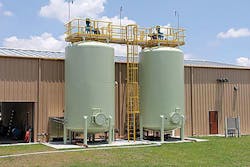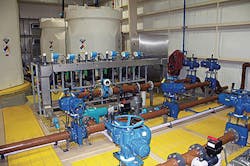| The chemical systems automatically inject a mixture of sulfuric acid, sodium chlorite, sodium hydroxide, ferric chloride, and sodium nitrite in two processing steps. |
After treatment, the odorless neutralized biosolids are sent to a centrifuge that dewaters to 19- to 24-percent solids, versus 12-percent with the drum thickeners. The dewatered material is then automatically transferred to a trailer with a built-in spreader. “We can fill the process tank in the morning, treat it [and] dewater it in the afternoon for pickup the next day,” Silveira said. “It used to take a month to fill a digester, then 40 days for aerobic digestion, which created odors and used electricity the whole time.”
He further explained that the automated system also makes it easier for operators. “We have many more parameters to watch on the monitors and cameras so we can see all the different areas,” he said. “If the trailer is getting full or if I have to do something else, I pause the system.”
There is no material that splashes out of the digesters to clean up, and samples are taken from built-in ports. “I don’t get messy anymore,” Silveira said. “I’m not exposed to the raw sludge nearly as often, and I don’t have to deal with the weather or odors.”
Next Chapter: Organics Recycling Facility
The groundbreaking for a new organics recycling facility at Haines City’s current wastewater treatment property site took place in May 2015. The city will own the building that NuTerra designed, is constructing and will maintain. Further, the facility will blend residents’ yard waste with wastewater treatment biosolids and other organic waste accepted from surrounding communities and commercial interests. NuTerra will market the resulting federal- and state-approved Class-AA/EQ compost product for unrestricted beneficial reuse locally and in surrounding communities.
The facility’s process control system - NuTerra’s proprietary design - will continuously monitor and automate the composting process. It’s a streamlined approach that eliminates the need to reposition probes and avoids disruption of the process from exposure to rain, humidity and other factors that impact the active composting and curing processes. While greatly simplifying the process, this approach ensures a high-quality end product and minimal odor nuisances for nearby neighbors.
“NuTerra is making it economically possible to live up to our state’s high environmental standards. By recycling and beneficially reusing biosolids, yard waste and other organic waste, we’re reducing disposition costs with far fewer trips to the landfill and mitigating nutrient and groundwater pollution,” Stripling said. “The facility will provide surrounding communities an economically and environmentally advantageous outlet for their organic waste.” In addition, offsetting the use of commercial fertilizers with compost by the local athletic fields will result in superior water retention properties and allow for the slow release of beneficial nutrients.
More WaterWorld Current Issue Articles
More WaterWorld Archives Issue Articles




